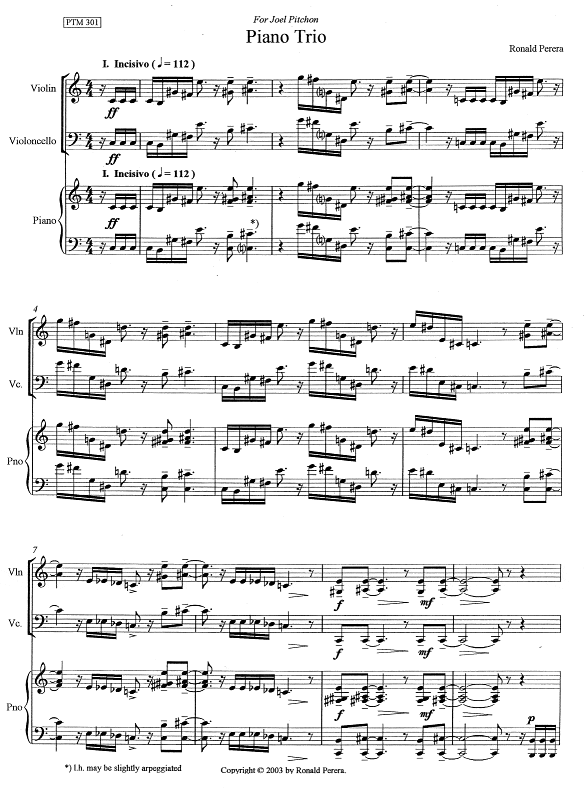Piano Trio: Violin, cello, and piano
Commissioned by Joel Pitchon. The second movement is based on the third movement (“The Symphony”) from The White Whale.
Movements:
- Incisivo
- Adagio cantabile e sostenuto (“The Symphony”)
- Scorrevole
| Composed: | 2002 |
| Duration: | 17:00 |
| Publisher: | Pear Tree Press Music Publishing distributed by Subito Music |
| Catalog Number(s): | PTM 301 |
Reviews:
Perera’s trio is lively and also very American in feeling without having any connection to jazz rhythms, but that doesn’t mean it isn’t invigorating. I was also impressed by his sophisticated handling of rhythm, moving quickly and expertly into neighboring tonalities with the mere flick of a pivot-point within his chords. He is even more adept at this than jazz composer Eddie Sauter was, and Sauter was unquestionably brilliant. Moreover, Perera accomplishes this without making it sound affected or as if he were “leaning into” the harmonic shifts for effect’s sake. He keeps the melodic line and its development going, but although he does begin and end his movements in a fixed key he does not stick with it. The second movement has a lovely effect in which the cello strums like a big guitar against the long-lined violin melody while the piano plays occasional chords sprinkles. As the music develops, Perera also changes both the music’s meter and pacing, introducing an ostinato rhythm with some edgy figures above it here and there. The last movement opens with stabbing figures which then move into a moto perpetuo.
Lynn René Bayley, The Art Music Lounge, Online, 4/2020
Ronald Perera (b.1941) follows next with his 2002 Piano Trio that exemplifies his harmonic daring. Writes Perera, who opted to pen his own pithy program notes for the present CD release, “I have employed what is often referred to as ‘extended tonality,’ including bi-tonality and added-note chords. Sections within a movement may often be distinguished by having their own key center without, for the most part, the use of traditional functional harmony.” The rhythmic patterns in the outer movents are incisive and challenging. Short-short-short-long and long-long-long-short-long patterns are divided and recombined, in the first movement, creating an off-kilter dance rhythm, while in the third the driving impulse is derived from a succession of four quick stepwise descending notes, followed by a short rest and a leap in the opposite direction. (Sound like fun?)
Strongly contrasted to these two formal movements, and indeed everything else in this album, is Perera’s second movement, called “the Symphony” and marked Adagio cantabile e sostenuto. This, the only vocally inspired music on the present progam, was derived from Perera’s earlier scene for baritone and orchestra, The White Whale, whose text was drawn from Chapter 132 of Herman Melville‟s Moby Dick. This is the crucial scene in which Captain Ahab unburdens his tortured soul to his first mate Starbuck. It contains a profound longing for peace and the consummation of his weary, obsessive quest for the White Whale, beginning with the line “And the air smells now as if it blew from a far-away meadow,” and ending with “Aye, toil how we may, we all sleep at last on the field.” The transparency of the musical structure Perera employs helps us understand this mood as immediately as if actual words were present.
Phil’s Classical Reviews, Atlanta Audio Club, Online, 5/2020

Audio Excerpt:
Joel Pitchon, violin, Volcy Pelletier, cello, and Clifton J. Noble, Jr., piano
Movement 1. Incisivo:
